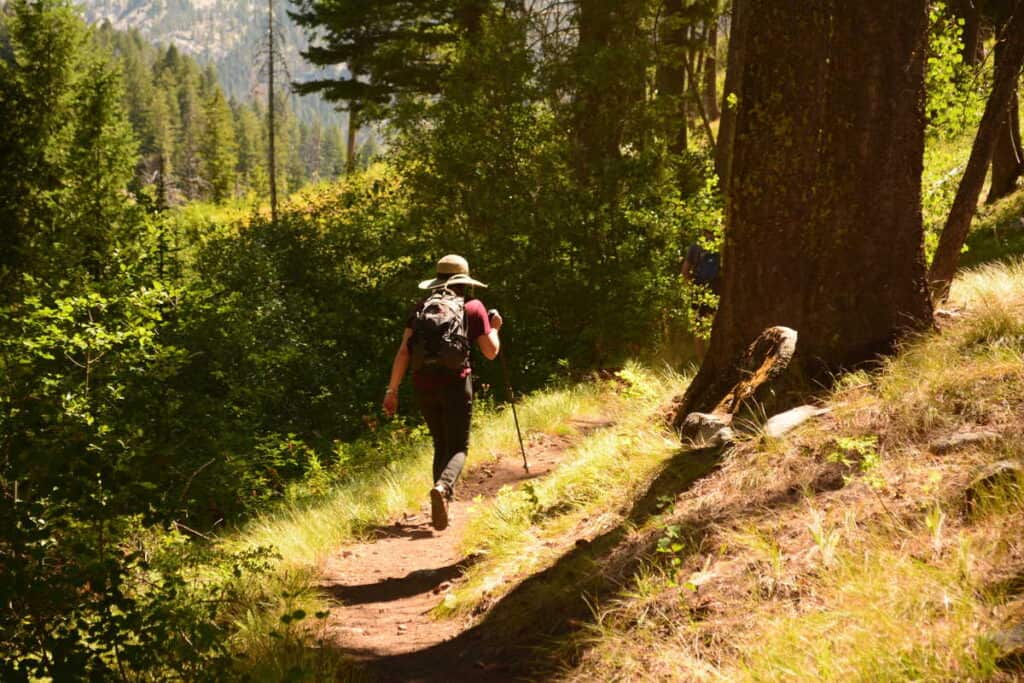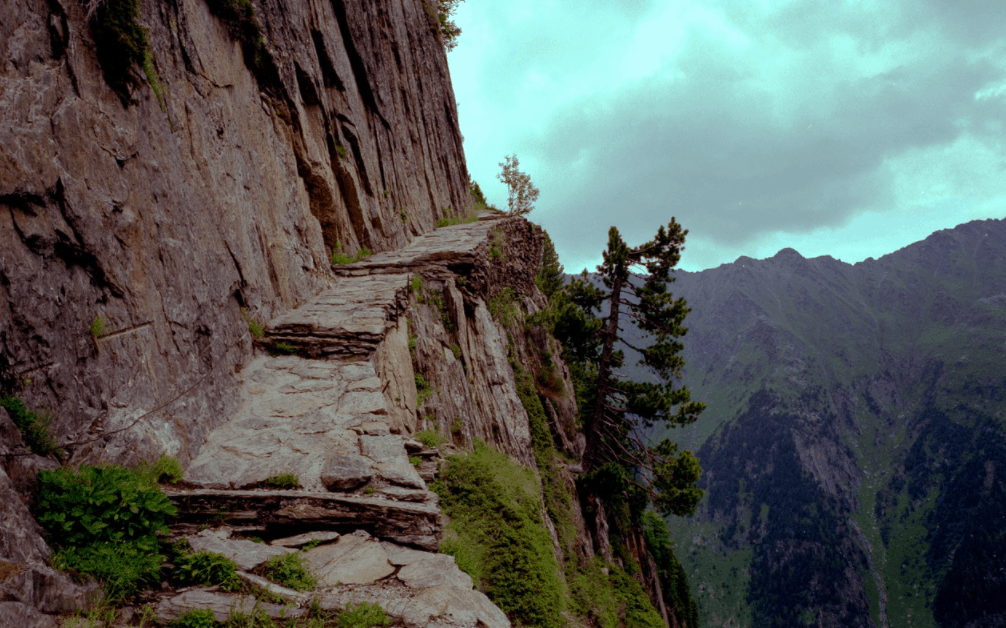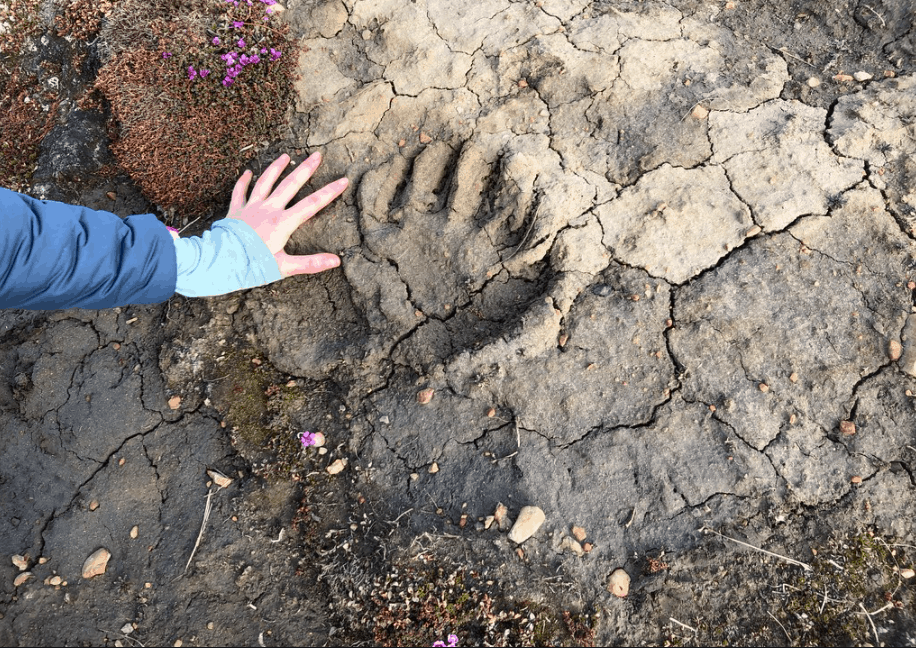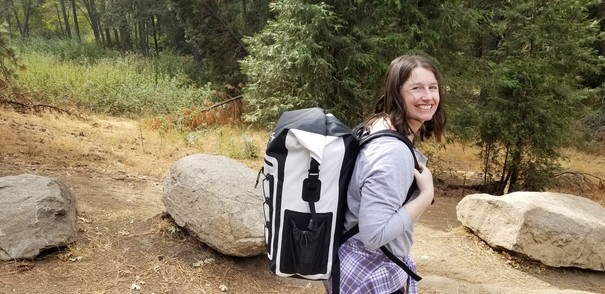Hiking alone is a spiritual experience. Not only are you taking in the breathtaking beauty of nature, but you have a chance to spend time with your own thoughts—checking in with yourself so that you can find peace of mind.
It’s also enriching to accomplish a hike by yourself. Self-reliance can make every aspect of your life more manageable.
I’ve hiked alone a handful of times. At first, I was hesitant and unsure of myself, but I had a massive confidence boost in the end. I made sure to choose a hike I had completed several times before, as well as a popular trail where I wouldn’t be entirely alone.
Lastly, I carefully packed my backpack, made sure I had a way to communicate my location, and let several people know where I was, and when I expected to return.
Thus the balance: how to hike alone as a woman while being safe.
There are many things to consider hiking solo as a woman.
Let’s go over several below.
Tips for Taking a Solo Hike
Start Small When Hiking Alone

If you are new to hiking solo, then start with a simple day hike, one you know you can easily complete because you’ve done it before.
Afterward, you can move up the ladder of difficulty to where you are forging paths through the wilderness on overnight treks. It’s all about the experience, and just as you gain experience in pairs or a group, you need to gain experience by yourself.
So start with a few hours and work your way up from there!
Know Your Hiking Trail
Start with a trail you have done before, where you are familiar with the route and terrain. Recognizing the trail’s landmarks and segments will be a comfort when you’re alone, especially for the first time.
It’s also a good idea to pick a populated trail so that there’s the likelihood of other hikers around if you get in trouble.
Your first solo hike is not the time to venture into the extreme wilderness.
Once you gain experience and confidence, you can open up your possibilities. Still, never hike somewhere where you have not carefully studied the route and terrain. There are lots of apps available that give real-time information on real trails. AllTrails and Map My Hike are good apps to have.
Know Your Limit

Don’t get too ambitious. Think about the best hikes you’ve done. You probably were pushed physically but not so far that you struggled to complete. Study those routes to determine your limit.
If you can easily hike two miles but over-exert yourself at five, then pick a hike at the lower end of your range. The same goes for elevation and altitude.
You want your first solo hike to be a pleasant experience, not one where you tire out halfway and worry about finishing.
Check Weather Conditions Thoroughly Before Hitting the Trail
That means don’t just rely on your one weather app. Really do some deep digging into the hour-to-hour weather conditions and keep checking up until you go.
You don’t want to get caught in a sudden downpour or cold blast. AccuWheather and Mountain Forest are good weather predictors.
Once you know the swing in weather that might occur during your hiking times, dress accordingly.
Research the Local Wildlife

You will want to know what kinds of animals you might encounter along your hike so that you are prepared. Is this area prone to bears? Coyotes? Rattlesnakes?
If you know the wildlife, you can plan on what defensive measures you need with you (like bear spray – more on that below). You’ll also want to read up on how to identify wildlife tracks—Nature Tracking has a long list of photos for you to study.
Have a Method of Communication
If you are hiking in the city, or just outside of one, you might have cell service. But please don’t plan on it. Most of the best nature spots have either inconsistent service or absolute zero. It would be best if you thought about how you can communicate with others if you suddenly need help. Invest in a satellite GPS tracker like Garmin or SPOT and make sure you know how to use the device to call for help before you hike.
You can check out both the Garmin or SPOT on Amazon to see if they are still available.
Communicate With Others
Please don’t go hiking alone without telling anyone. You need friends and family to know not only where you are going, but when you plan to return so they can check-in on you if you don’t arrive. Timing is everything for hikers who get lost or incapacitated. Always know your coordinates. This is where the GPS trackers come in.

More hikers get hurt that are doing short, day hikes. This is because they are underprepared for sudden weather changes and other conditions. This is why someone knows when you’ll be back, even on a small hike.
These are the big things. Next, we’ll tackle all of the little things you’ll need to carry with you.
Must-Have Items for a Woman Hiking
From the items in your pack to what you wear, you need to think through every detail before you solo hike. As a woman, there’s also an added measure: defense.
Here’s what you need to consider:
- Water – Make more than you think you will need. Since 2 liters of water a day is recommended, I’d say take more when exerting yourself outdoors.
-
Appropriate Footwear – Hiking boots make all the difference since they provide support, protection from the elements, and most are water-resistant. Check out our post on hiking boots and how to get the best fit.
-
Appropriate Clothing – Long pants are better than shorts, and long sleeves are better than short sleeves. Regardless of heat or cold, you want a layer of protection from branches, brush, and bugs. And even if you are hiking in warm weather, bring layers. Many locations cool when the sun goes down or slips behind a cloud.
-
Sun Protection – Speaking of that sun…Hats are great at protecting you from the sun’s rays and keeping your face cool. Also, any bug that might fall from above will land on your hat and not your head. For real, this has happened to me more than once.
Sunscreen is also a must for any exposed skin.
-
Portable Charger – If you have cell service (a luxury) or need to access your hiking app (a must), you need to have a charged battery. Amazon has this small, portable power bank from Anker, so you won’t have to worry about losing your phone charge.
-
First Aid Kit – Whether alone or with others, you should always have a stocked and up-to-date first aid kit. Make sure it fits easily in your pack. Amazon has good kits in different sizes. This was the best First Aid kit I could find on Amazon at a good price.
-
Stun Stick – Hiking sticks help with difficult terrain, but a stun stick can also double as a defense. Stun sticks will protect you from a wild animal or a threat. Check the rules in your hiking area to see if they are allowed. Try this Stun Stick on Amazon.
-
Whistle – Yep, a whistle. If you come into trouble, a whistle sound will travel much further than your voice.
- Survival Knife – Having a good knife is always a good idea when out on the trail. Outdoorbeing has tons of information on how to choose one.
-
Snacks – Take snacks, even if you plan to eat beforehand. You might need to re-energize. Think power bars, granola bars, nuts, etc.
Make sure to bring a plastic bag to wrap up your trash, so you don’t litter and don’t bring any food items that are too smelly—potent food smells attract critters and wildlife. You can also use a Waterproof Dry Bag for this any a ton of other things. We have a great guide on everything about Waterproof Dry Bags.
-
Bear Spray – Similar to mace, bear spray will not only dispel a bear, but it can work to protect yourself against any threat, animal or human, you encounter on your hike. This is the Most Potent Bear Spray I could find on Amazon.
-
Carry a Personal Locator Beacon – As stated above, a satellite GPS locator is your best friend on a hike.
Is it Weird to Hike Alone?
Absolutely not! Hiking solo can be great for mental clarity and can provide a valuable self-check-in. Ask yourself this: when was the last time you were able to focus solely on yourself?
If that answer is not lately or never, then consider hiking! I used to hate to go anywhere alone. But now I plan for times I can get out and spend time with my thoughts. I find I come home invigorated after having reset my priorities.
Is Hiking Alone Safe?
Yes, hiking alone can be safe if, and that is a big if, you are well prepared. Just like when you go hiking and camping with others, your success or failure when venturing into nature all comes down to your knowledge and preparation.
The same goes for women. Think about any dangerous encounter you might have, and plan for it. Don’t skip on any of the tips and must-haves on this list, as they are all important for comfort and safety.
Also, when hiking alone, don’t listen to music.
I know this might seem hard. Music is usually what we turn to when doing solo activities like driving.
But music can distract you when hiking. You need to be aware of your surroundings so you can hear any approaching hikers or wildlife. Awareness is everything. Keep the music at home.
Check out our thought about playing music while hiking in this post, Is It OK to Play Music While Camping & Hiking?
Hiking Alone at Night
Hiking alone at night has the added danger of darkness. I know that seems obvious but think back to how dark it can get when you are outside in nature with no other ambient light sources besides the moon (if it’s not obscured).
You won’t see your surroundings, and it might even be difficult to see the trail. This type of hiking should only be attempted if it’s an area and a trail you know extremely well and have traveled often.

You’ll also need added accessories like a headlamp (yes, you need one), a flashlight, and reflective clothing. The night is a time when you want to see and be seen. If you’re camping solo, make sure you have a secure spot and that you are away from the road, as many dangers can come from cars driving by.
To read more about camping and the essentials you will need, read our post on camping essentials. If you’re looking for a printable checklist of what you need to go camping and hiking, just out our Beginners Guide to Camping in the sidebar or at the bottom of the page if you’re on mobile.
Change Your Mentality
Your biggest hurdle to hiking solo is your own thinking. As women, we have often been taught (even subliminally) that being alone is unsafe. That mentality isn’t useless—it helps create an awareness of yourself and your surroundings that’s invaluable.
However, this thinking can also lead to some anxiety about any solo situation. Hiking solo can increase your self-confidence and your sense of power. This power will carry over into all aspects of your life.
So there you go. Hiking solo can be an enjoyable experience. Just remember: research, prepare ahead of time, communicate with others, and set your limit.
If you’re ready to hit the trail you should read our article about How to Prepare for a Hike the Night Before.








